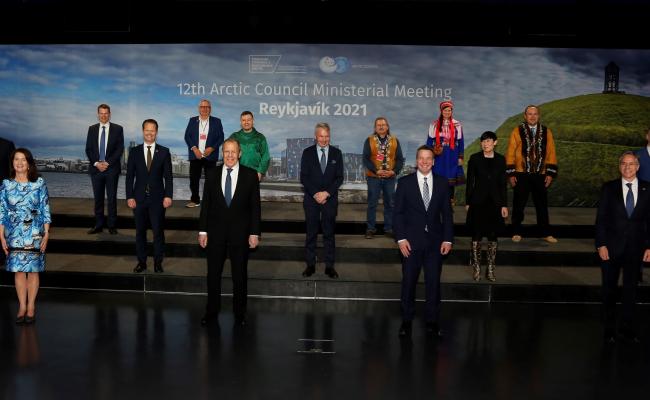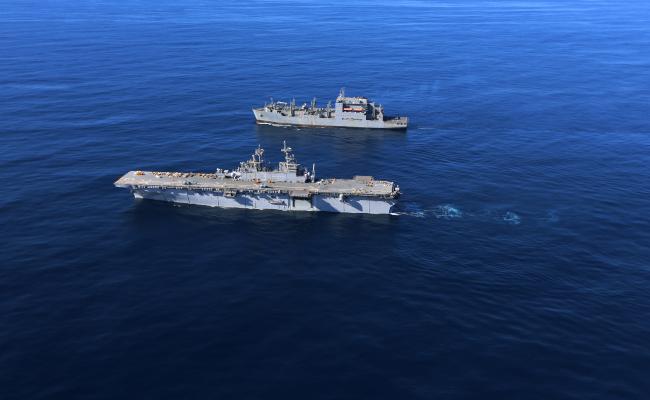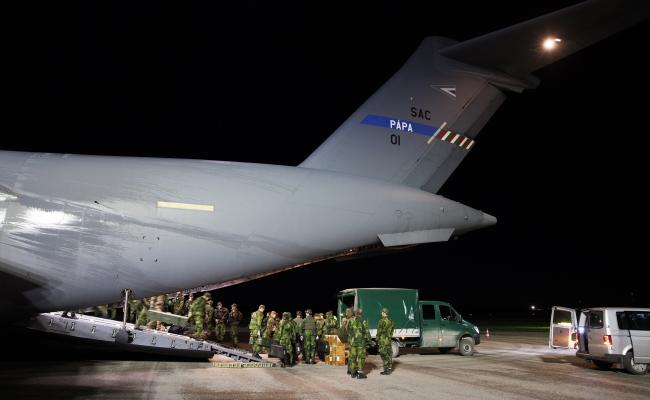USA’s Arctic Coordinator: “We Do Not Want to Change the Structure or Membership of the Arctic Council”
The US Coordinator for the Arctic Region James P. DeHart was in Tromsø this week to participate at the Arctic Frontiers conference. (Photo: Trine Jonassen)
“Creating an alternative structure to the Arctic Council is not on our agenda. We believe the Council holds its greatest value as a circumpolar forum including all the eight Arctic states and binding together the people who live throughout the entire region”, says James P. DeHart, US Coordinator for the Arctic Region.
The future of Arctic cooperation is still a highly relevant theme, also in light of the currently over two-months long pause of the Arctic Council, introduced as a response to Russia’s launching a war against Ukraine.
Many now wonder about how to continue the work of the Council. Reports say that the Arctic countries’ diplomats, in particular their Senior Arctic Officials, are working hard to find solutions. And researchers bring their views and proposals to the table too.
One alternative continuation lies in the seven western Arctic states of Norway, Sweden, Finland, Denmark, Iceland, Canada and the USA’s establishing a new organization for multilateral cooperation in the region.
“Russia should be given a clear choice: Voluntarily absent itself from the Arctic Council for the time-being or the other seven Arctic States will establish a parallel forum which will forever doom the current Arctic Council”, Researcher at The Brookings Institution Jeremy Greenwood recently wrote in an op-ed in High North News.
US Coordinator for the Arctic Region James P. DeHart of the US State Department refutes the idea of replacing the Council with a new organization. He recently visited Tromsø, Norway in relation to the Arctic Frontiers conference.
“Creating an alternative structure to the Arctic Council is not on our agenda. We believe the Council holds its greatest value as a circumpolar forum including all the eight Arctic states and binding together the people who live throughout the entire region”, DeHart says to High North News.
With time, it [the Arctic Council] will resume its work with all the eight Arctic states, we believe.
Two tracks back to cooperation
“We strongly felt that we had no other choice but to pause cooperation through the Council as part of our efforts around the world to isolate Russia and make it very clear that its actions in Ukraine are completely unacceptable”, DeHart retells and continues:
“What has not changed is the fact that we consider the Arctic Council the prime forum for Arctic cooperation. We want to maintain the Council in a longer term. Over time, it will resume its work with all the eight Arctic states, we believe.”
According to him, it is on a shorter-term basis essential that the Arctic states soon find a way back to multilateral cooperation, and then initially without Russian participation.
“As Arctic states, we have a responsibility to continue the important work on climate, environmental protection, biological diversity, and sustainable development for the population in the region. Now, we are looking for a way to continue – without Russia, for starters. However, we do not look into changing the basic construction or membership of the Council. But we want to resume cooperation, and I expect us to do that soon”, DeHart says.
Norway’s Arctic Ambassador and Senior Arctic Official Morten Høglund has also expressed a focus on avoiding measures that may represent obstacles to returning to normalcy for the Council.
James P. DeHart says he expects Arctic cooperation to be resumed soon, initially without Russian participation, and stresses an emphasis on climate work in the Arctic region. (Photo: Trine Jonassen)
There is probably more emphasis on the transition from Russian to Norwegian chairmanship in the Council, and this is probably discussed among the member states even though nothing is said in public.
Potential openings
DeHart and other representatives for ‘the Arctic Seven’ keep their cards close to the chest when it comes to what concrete adjustments they consider in order to enable resumption of Arctic cooperation.
When asked if they are looking into the possibility of “thawing” research cooperation and indigenous cooperation on working group level at the Council, unlike political cooperation on minister and ambassador level, DeHart responds:
“I will not make quite that distinction, however, much of the Arctic Council’s activity is very practically oriented in health, education, and climate measures. We want to continue as much of this as possible.”
Last week, DeHart participated at the opening of the Arctic Frontiers conference along with a.o. Norwegian Foreign Minister Anniken Huitfeldt (Labor). She then said that the Norwegian preparations for taking over the chairmanship at the Arctic Council from Russia are continuing. The handover is scheduled to take place at the next ministerial meeting in May 2023, and DeHart expressed eagerness to see this happen.
At a later seminar during the conference, Arctic-expert Oran Young highlighted the possibility for moving up the chairmanship transition.
“A speedy resumption of circumpolar cooperation is highly unlikely. There is probably more focus in the Council on the transition from Russian to Norwegian chairmanship, and this is probably discussed between the member states although nothing is said in public”, said Young, Professor Emeritus at the University of California, Santa Barbara.
In the aforementioned op-ed, Greenwood points out that the Council’s procedural regulations have to be altered in order to speed up a transition of the chairmanship prior to the next ministerial meeting.
Still an eye to the climate threat
Besides discussing the crossroads for the Arctic Council and how Russia’s role in the Arctic can be addressed under the current circumstances, DeHart says the USA has a contemporary focus on climate work in the Arctic region.
“At the Arctic Council Ministerial Meeting in Reykjavik last year there was strong agreement between the member states – including Russia – that climate changes have to be on top of the agenda. The ministers then agreed on a ten-year strategy that prioritizes climate work”, he says and continues:
“This largely has to do with black carbon, which is a particularly Arctic problem when it covers the ice and accelerates melting, with the subsequent effect on global temperatures. Our goals have been to address this and to encourage both Arctic as well as non-Arctic states to strengthen their commitments to reduce black carbon in the Arctic. This is a very important initiative area, in my view.”
DeHart also refers to the USA’s special envoy for the climate John Kerry’s recent visit to Oslo.
It is our intent to keep the Arctic region void of conflicts and to avoid unnecessary militarization of it.
Goal of a peaceful, low-tension region
American diplomats’ mantra when it comes to the Arctic is that the USA wants this to be a peaceful region with low tension.
According to the Arctic coordinator, there is good cross-ministerial cooperation about this goal, including the Ministry of Defense.
“We are working to keep the Arctic peaceful, calm, and oriented towards cooperation in a number of ways. This goal is included in the assessment of our force positioning in the region, as well as when we work with our NATO allies and train with them. It is our intent to keep the Arctic region void of conflicts and avoid unnecessary militarization of it”, DeHart says.
“We are also engaged in cooperation all over. Besides seeking ways in which to re-start cooperation at the Arctic Council, we continue scientific cooperation, such as in the area of climate, with international partners in all ways possible”, he adds.
No immediate danger
Conflict spillover from Ukraine to the Arctic is an issue long covered by High North News, also before the Russian invasion of Ukraine in February.
A worrying question in the current situation is whether war will spill over into the Arctic region, and if so probably through the Baltic Sea area.
During the opening of Arctic Frontiers, Director at the Finnish Institute of International Affairs (FIIA) Mika Aaltola said that he fears that the war in Ukraine may spill over into the Arctic region. How do you judge the risk for this to happen? Is this an American concern as well?
“We see no immediate risk for the conflict spilling over from Ukraine to the Arctic. Thanks to the courage of the Ukrainian people, Putin has his hands full in Ukraine. In addition, Russian forces from the Kola Peninsula have been used in the war, and they have allegedly suffered major losses”, DeHart says and continues:
“So, as per now, we do not see any direct risk of spillover. However, we have been worried about Russian military activities for a long time now, long before this last invasion of Ukraine. In general, it is about lack of transparency and some irresponsible behavior from the Russian forces.”
We find that we have the channels we need to de-escalate conflicts when necessary, be it in the Arctic or other places around the world.
Early March, Reuters reported that the US Ministry of Defense had established a new hotline with Russia’s defense ministry in order to prevent “miscalculations, military accidents, and an escalation” in Eastern Europe in light of the Russian invasion of Ukraine.
Is there any form of communication between the USA and Russia about the Arctic region when it comes to military activity or other kinds of issues?
“We have a series of different communication channels with Russia that we can make us of. We find that we have the channels we need to de-escalate conflicts if and when necessary, be it in the Arctic or other parts of the world”, DeHart says.
According to him, American-Russian communication about the Arctic region has quite likely taken place so far this year, however, he is not familiar with any recent incidents in which the parties have communicated due to pressing causes.
American activity in the High North
The USA’s military activity in Norway as well as the High North has increased significantly in recent years.
This winter and spring, American forces’ presence in Northern Norway has probalby been particularly high, with large participation in the Norwegian-led allied military exercise Cold Response in March and subsequent training activities. Last week, hundreds of army soldiers from Alaska were training in inland areas in Troms, Norway.
Many American troops have arrived in Northern Norway this winter and spring in order to exercise. Does the USA have a limitation on this resource allocation? Will we see as much or maybe even more American military activity in Northern Norway in the coming time?
“We will surely continue this activity. We have global commitments and must maintain the ability to operate anywhere, including in a cold climate. The US Marines have come to Norway on a rotational basis to exercise together with Norwegian forces for years now, and it has been most productive”, DeHart says.
“Norwegian forces have a lot to teach us when it comes to operating in extreme cold conditions, for instance how to do it when it comes to clothes and equipment. So, we will continue being active with such training, I am sure of it. We appreciate the Norwegian forces’ snow-how”, he adds.
Also read
This article was originally published in Norwegian and has been translated by HNN's Elisabeth Bergquist.




